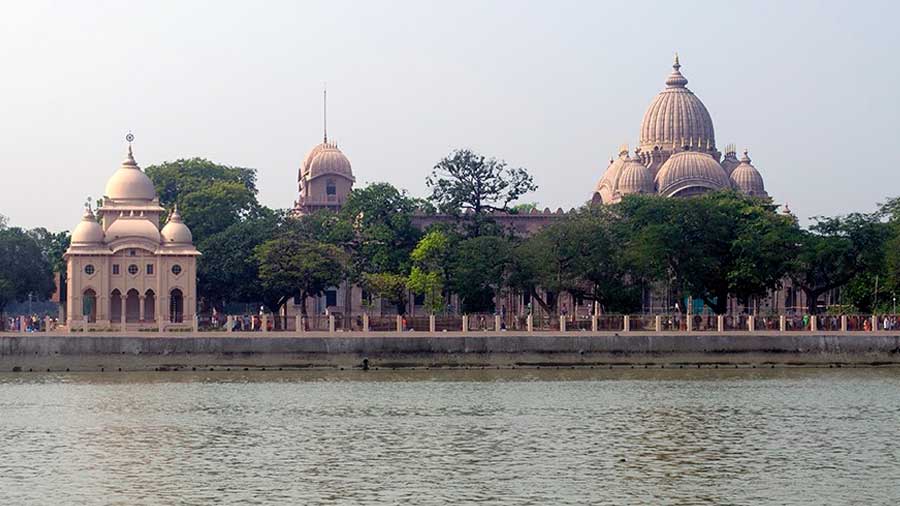Barrackpore has a special niche in India’s history. It was here that Mangal Pandey revolted against the English starting the First War of Independence. And this was also India’s first cantonment, which has led to an abundance of colonial heritage dotting the town.
I had the good fortune to visit Barrackpore with the man who literally wrote the book on its cultural legacy.

The man all heritage lovers must thank; my selfie with Soumen Mitra
Soumen Mitra, the former commissioner of Kolkata Police and currently director of training, has renovated the Raj-period buildings scattered like gold dust within the grounds of Barrackpore’s Police Training Academy. And even more impressively, he has inspired his fellow police officers to be heritage enthusiasts, keeping these treasures alive for future generations.
Visiting Barrackpore with Soumen was for me a day full of learning.
India’s first cantonment, on the Hooghly 16 miles upstream from Kolkata
After the English victory at the Battle of Plassey, the East India Company fixed its talons deeper into Indian soil. It was decided to further strengthen Fort William, with part of the defence plans being to build three cantonments around Kolkata.
The first of these cantonments was in Barrackpore.
Strategically located on the Hooghly 16 miles upstream from Kolkata, it was close enough to Chandernagore to keep an eye on the French there. Work was started on the bungalows, barracks and parade grounds that a cantonment required and overseen by a newly formed cantonment board.
When Lord Wellesley became the Governor General in 1795, he decided to boost Barrackpore and develop it as a twin city to Kolkata. The plan was to have two Governor Houses, one in each city, with the administration shuttling between the two.
Kolkata’s massive Governor House (Raj Bhavan) was completed by 1803. But before Barrackpore’s version could be developed, the directors of the East India Company cried foul. For them, building two palace-like residences was a waste of Company money, and charging Wellesley with the misuse of funds they recalled him to London.
What was left as Wellesley’s legacy was the Barrackpore Trunk (BT) Road, built to link Kolkata with Barrackpore. It passed through thick jungle at the time and so Wellesley had specially constructed Semaphore Towers — which used a mix of flags and fire signals — for safe passage. One tower still stands on the grounds of Barrackpore’s Flagstaff House, but is unfortunately out of bounds being part of the Bengal Governor’s official residence.
Barrackpore gets its Government House (and now it’s been renovated)
What was conceived by Wellesley was completed by Lord Hastings in 1823.
Initially, there were few believers. Hastings’s predecessor, Lord Minto, had this to say about Wellesley’s grand scheme: “…it would have been magnificent, I have no doubt, but in perfect contradiction with every purpose of the place. It would have been to come from Calcutta to Calcutta again… the same multitude of troublesome attendants…. I am extremely glad it has been stopped”.
But once this impressive mansion was completed, the “regal palace on fair Hooghly’s stream” grew in popularity to become a much-loved country residence for successive Governors and movers and shakers of the Raj.
Barrackpore’s Government House has been renovated and it’s easy to imagine its past glory. Having driven the short distance from Kolkata I was met at the Police Academy gates by a policeman on a motorcycle, who I followed on to the cantonment’s clean roads. There was greenery all around me and small pukurs dotting the landscape.
I met Soumen in his office, and together we climbed on to an open-top jeep for a tour of Barrackpore’s heritage sites. First up was Government House and its grounds, overlooking the vast Hooghly river.

The Reception Hall: balls and dances and pomp and glory
Shah Jahan’s fountain from A(gra) to B(arrackpore)
When Lord Hastings gave final shape to Government House, a big contribution was the marble fountain on the front lawn. This was originally from Agra, as part of Shah Jahan’s hammam in his zenana. It caught Hastings’s fancy when he visited Agra, and he had the marble slabs “with much carving on them” shipped on barges from Agra to Barrackpore and installed here. For many years this Agra fountain was neglected and buried in mud, but somehow it survived, till restoration has set it right.
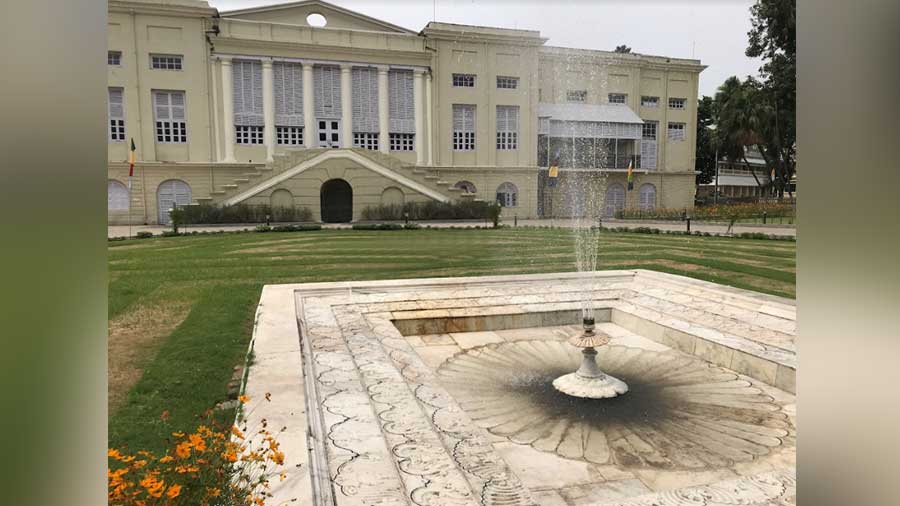
Shah Jahan’s Agra fountain had caught Hastings’s fancy
We climbed the steps of Government House and entered a vast ballroom, with the original ceiling still intact and a spring-like floor for dancing. We stood dwarfed under the 20-foot-high ceilings as Soumen pointed out the huge iron beams used earlier for pankhas to keep the sahibs cool. We visited the dining room, billiards room, living suites and the basement area for servants (which now has an auditorium and displays), and it was plain to see why this home was remembered so fondly in countless memoirs and letters of British rulers and their families.
The great banyan tree, under whose shade….
Adjacent to the mansion’s neatly trimmed front terrace was a sprawling banyan tree which is 350 years old. The tree has been here since before the East India Company bought this land in Barrackpore, and though recently damaged by cyclone Amphan it remains most impressive.
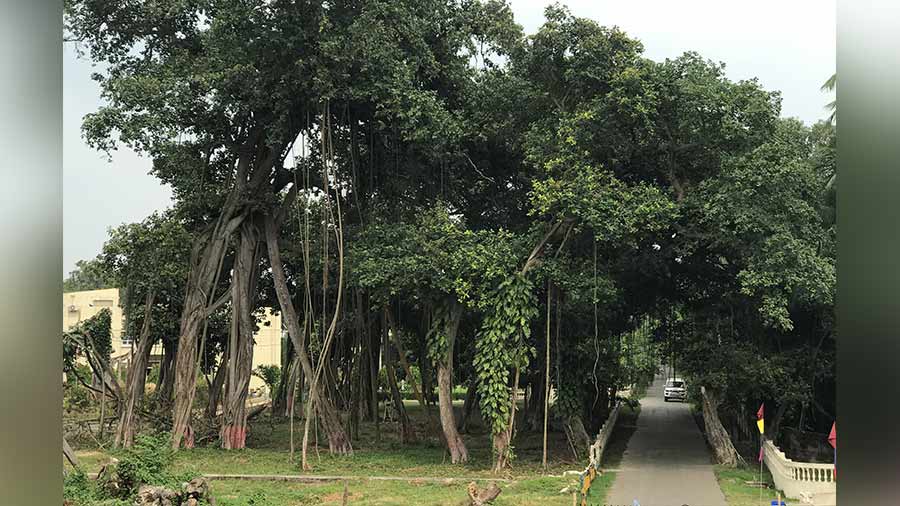
Fun under the banyan tree for a long list of celebrities
There is probably no other tree in the world that has provided shade to as many luminaries as this one has. King George V and Queen Mary had Christmas lunch under it, the “…branches forming a canopy over the guests as the squirrels chattered and the mynahs sang."
Also using it as a sit-out were Winston Churchill, Sir Stamford Raffles (the founder of Singapore), King Albert of Belgium, Prince Wilhelm of Germany, Prince Gustaf of Sweden, General Chiang Kai-shek (he was here in 1942, as a state guest of the Allies to keep him away from the clutches of Japan), Jawaharlal Nehru (also in 1942, to meet Shek), Amir Dost Mohammed (the ruler of Afghanistan), Bishop Heber….
Lady Canning’s poignant grave
Among all the Governors and their wives who stayed at Barrackpore, the one most in love with it was Lady Canning.
Charlotte Canning was a painter and a naturalist. She was born in Paris (her father being the British ambassador to France), served as Lady of the Bedchamber for Queen Victoria with whom she had a close friendship, and married Lord Canning with whom she moved to India when he was appointed Governor-General. She found Governor House in Kolkata dull, and much preferred spending time in Barrackpore instead, indulging in her passions of painting and botany.

Here lies Lady Charlotte Canning, quietly by the flowing Hooghly
Lady Canning’s time in Barrackpore had its share of drama, for it was during her husband’s tenure that the 1857 revolt occurred. In fact, Lord Canning was given the term “Clemency Canning” for his statesman-like approach to end the uprising, and is credited with the smooth transfer of power once the decision was taken to move governance from the East India Company to the Crown.
To get to Lady Canning’s grave, we walked past the banyan tree and along the river, retracing the steps she herself would have taken. Charlotte would spend many hours sketching at a particular bend of the river, where apparently the winds were such that the temperature dropped by a few degrees. She was buried at her favourite spot.
I stood beside Lady Canning’s white marble grave, set in a well-maintained lawn. There was indeed a lovely, crisp breeze blowing across the wide river and it was true… the temperature was a few degrees lower! I could see the former Dutch settlement of Serampore on the opposite bank of the Hooghly, its church steeple visible; a scene that Charlotte Canning had often painted in her watercolors.
Lady Canning had died in 1861. She was due to return to England, and decided to visit Darjeeling before she left. On her way back to Kolkata she got malaria, and within a few days died at Kolkata’s Governor House.
A devastated Lord Canning (they were childless, and only had each other) carried her body to Barrackpore “in the dead of the Indian night”, to be buried, as he described in a letter to Queen Victoria, at “…a beautiful spot; looking upon that reach of the grand river which she was so fond of drawing…. and amongst the bright shrubs and flowers in which she had so much pleasure.” The small funeral was private, with just her husband and a few staff, and she was lowered into this grave at daybreak on November 19, 1861.
Beside the grave is a statue of Lord Canning astride a horse, which had previously been located at the Governor House in Kolkata before being bought here. Canning now looks eternally over his wife’s grave, in this quiet corner of Barrackpore which she loved.
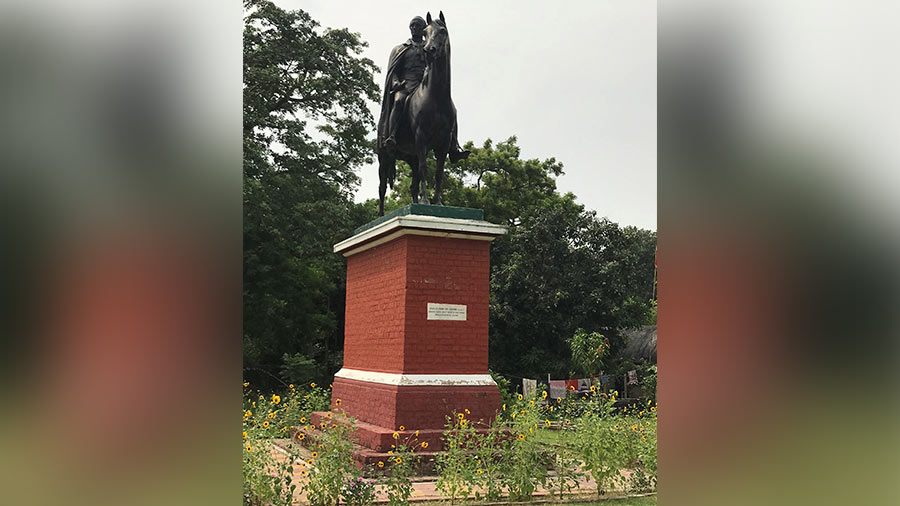
Lord Canning keeps watch over his wife’s grave in Barrackpore
Myall King, the wonder horse from Australia
Before leaving the Police Academy grounds, there was one last quirky monument that Soumen wanted me to see.
Situated within a bungalow romantically named Honeymoon House — for this was where honeymoon couples were lodged — is a small shrine built in tribute to Myall King, a champion horse from Australia.
Honeymoon House was now the residence of Debabrata Das, Inspector General of the Police Academy, and he took me inside the compound for a look. At one corner of the lawn, beyond chicken coops and a vegetable patch, was the pyramid-shaped tomb for Myall King.

The eccentric tomb of Myall King, champion horse who won all there was to win
The horse was buried here by a previous resident of Honeymoon House, the distinguished William Beresford, “sportsman, officer and winner of the Victoria Cross”. When Myall King, his favourite racehorse and winner of trophies all over India, broke his leg while jumping hurdles and had to be put out of his pain in 1893, Bereford composed this poem and buried the champion horse within his own compound.
“Myall King has been shot, ran the pitiful story,
We heard in Calcutta on last Tuesday eve;
But that such a sad ending had come to his glory,
We listeners indeed found it hard to believe….
Yet, if there’s a future for men and for horses,
Perhaps our old hero we once more may see,
Grazing free on sweet clover in meadows celestial,
Happy as sportsman all wish him to be”
Beyond the Academy grounds: temple, church and a shrine
Barrackpore was not done yet. Outside of the Police Academy are three more attractions worth visiting.
The Bindee Tiwari shrine is about a mile away, past the train tracks of the Race Course train station, which was built by the English to send racehorses up from Kolkata for the Barrackpore races.
Though Barrackpore is recognised for the Mangal Pandey-led 1857 uprising, these grounds actually witnessed two mutinies. In 1824, after the East India Company had seized parts of Assam with the Anglo-Burmese war, reinforcements were required there. The Bengal Infantry, which had just marched 1,200km from Mathura were now ordered to further march 800km from Barrackpore to Burma. They refused, demanding better transportation and a higher allowance. The agitation was crushed, with about 180 sepoys losing their lives, and the leader Bindee Tiwari was arrested and chained to a peepal tree, with his body left on public display. The Bindee Baba shrine is erected at the site of his execution.
The memorial is maintained by the Army as it falls within the Assam Regiment’s compound. It is said that Mangal Pandey would visit this shrine to gain inspiration, when he fired the first shot of the 1857 revolt, some 33 years after Bindee Tiwari.
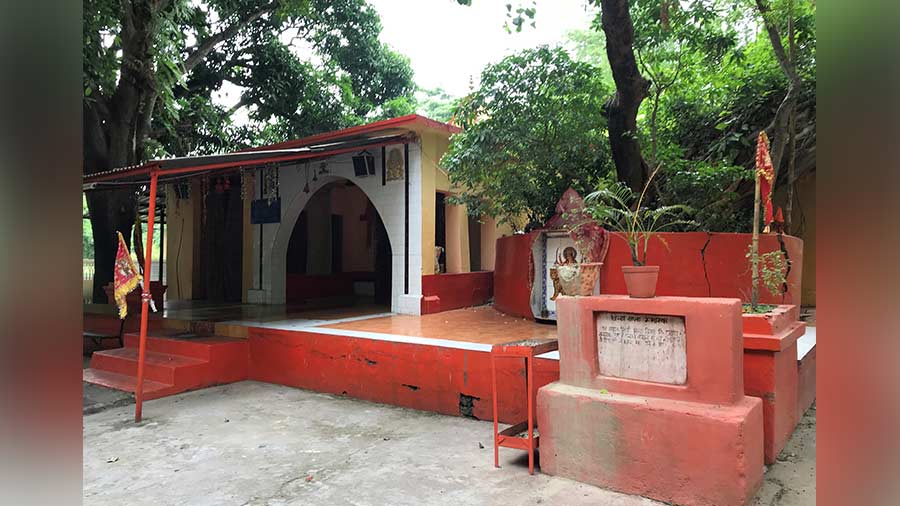
Bindee Baba Temple is at the spot where Bindee Tiwari was executed
A short distance from here was the Garrison church, now called St Bartholomew’s. This small church was built in 1831, close to the barracks for English soldiers and their families.
Being the only visitor, I was left alone to wander the church’s cool walls and wooden pews, spending time to read the memorial plaques on the walls. What struck me most was how many children, wives and soldiers had died very young, or the many who had drowned in the Hooghly.
While leaving the church, I saw fir trees within its beautiful garden, mixed with the mango and other native trees. I could imagine the homesickness of the English who had planted it, a reminder of home.
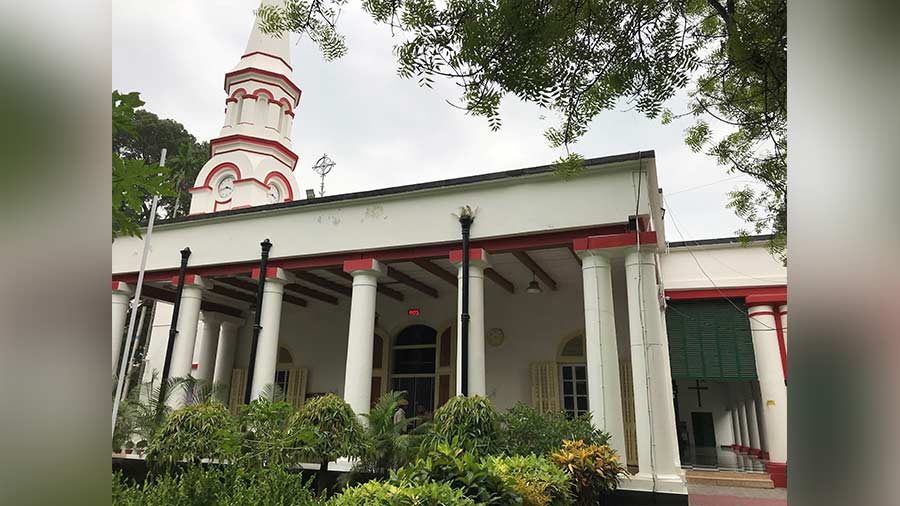
Garrison church: a slice of colonial history that survives
The Annapurna temple was my final visit. Built in 1875 by Rani Rashmoni’s daughter and modelled on Kolkata’s famous Dakshineswar temple, it is said that Ramakrishna Paramhansa himself was present both for the selection of the land as well as the temple inauguration.
I arrived mid-afternoon and the temple was closed. It would open at 4.30pm, so I waited in the temple courtyard ringed with the caretakers’ offices. In a while I heard the sounds of conch shells, cymbals and drums start up near the river, and the priest appeared in dhoti and kurta to open the temple locks.

Barrackpore’s Annapurna mandir
I took off my shoes to join the short line of devotees waiting patiently to enter. Inside the temple were two idols side by side, of Devi Annapurna and Lord Shiva. I prayed, thanking God for a fulfilling and safe day, and was handed prasad of mango, banana and puffed rice.
Sensations that can never be forgotten
We got back on the highway for Kolkata. I could settle into the car, thinking of all the discoveries for today.
I had caught a glimpse of Barrackpore’s high life. What this place would have been during its glory days, before Shimla replaced it as English society’s favoured spot. The rise of Shimla had pushed Barrackpore to relative obscurity, but its monuments still tell us of its past prominence.
Who could describe Barrackpore’s charms better than Lord Curzon (the more I read of Curzon’s notes and letters, the more I think the man should have been a poet…): “In later days the charm of the place to an overworked man lay not merely in the enjoyment of its restful beauties… but in the journeys up and down the river in the twilight of a Saturday evening… to leave the city in the late afternoon and, after tea on the deck, to lie on a lounge chair and watch the changing panorama of the river banks… the thick fringe of the vegetation and feathery palm tops; the smoke of the native villages, the white clad figures moving up and down… the glare of the electric light suddenly switched on in some great jute mill… and then, when light had vanished and all was swathed in shadow, to land by the glimmering tomb of Lady Canning, and to walk up the gravelled terrace to Barrackpore House, the hand-borne lanterns twinkling in the darkness ahead – these were sensations that can never be forgotten”.
Thank you, Police Academy, for keeping this alive.
Adil Ahmad is a Kolkata-born discoverer deeply curious about the city’s heritage and history. He can be reached at hello@indiaheritage.in

